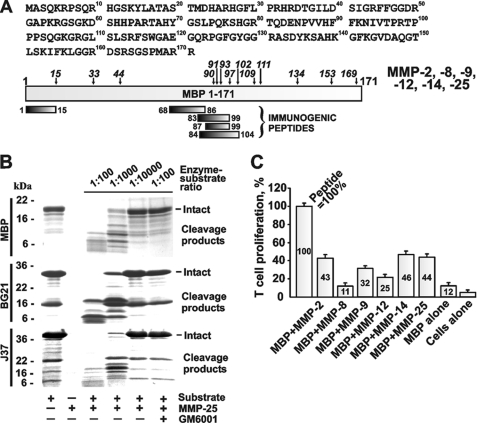FIGURE 3.
MMP proteolysis of MBP and activation of the specific T cell clone. A, 1–171-residue sequence of human MBP (GenBankTM accession number AAH08749). The immunogenic regions are shown at the bottom of the panel using the MBP residue numbering. Following the MBP cleavage by MMPs, the mass and, consecutively, the sequence of the digest fragments were determined by MALDI-TOF MS. The italicized numbers indicate the positions of the cleavage sites. B, MMP-25 proteolysis of MBP, BG21, and J37. Where indicated, an inhibitor (GM6001) was added to the reactions. C, MMPs cleave MBP and generate the N-terminal peptide that stimulates the proliferation of the specific T cell clone. MBP (5 μm) was cleaved by the indicated MMPs (an enzyme/substrate molar ratio of 1:100). The irradiated splenocytes from B10.PL mice were incubated with the cleavage reactions. The PGPR7.5 T cells specific for the murine 1–15-residue MBP peptide and [3H]thymidine were then added to the reactions. The incorporation of the label into the T cells was measured by liquid scintillation counting. For MBP alone, intact MBP (5 μm) was added to the cells. For cells alone, no peptide was added. For peptide, the 1–15-residue ASQKRPSQRSKYLATAS MBP peptide (5 μm) was used as a control (= 100%). The numbers show the percentage relative to the peptide control. The experiments were repeated four times, and the data represent the mean ± S.E.

